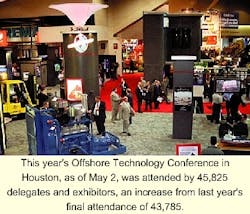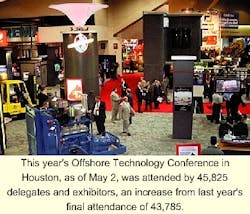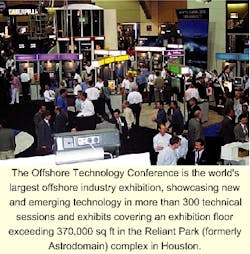OTC: focus on deepwater costs, lands access, environment and safety norms
Contributing to this article were OGJ Senior Writer Sam Fletcher, Senior Staff Writer Steven Poruban, and Staff Writer Paula Dittrick.
This is the first of two articles rounding up coverage of the Offshore Technology Conference. This week: A look at the key themes at OTC. Next week: a roundup of OTC technology highlights.
Deepwater cost containment, US lands access, global environmental concerns, and the standardization of safety and environmental practices were the dominant themes that emerged at last week's Offshore Technology Conference in Houston.
Undergirding those themes was a recurring call by a number of speakers for heightened emphasis on safety. That reflected the somber note sounded at OTC's awards luncheon, when Petroleos Brasileiro SA dedicated its distinguished achievement award for technological innovation to the 11 crew members who died fighting fires on the ill-fated P-36 platform that sank off Brazil earlier this year (see related story, p. 22).
Canada's East Coast received special attention at OTC this year, as the subject of a special session and a press briefing by provincial officials (see related story, p. 24).
Also at OTC, a Kerr-McGee Corp. official outlined a novel leveraged-leasing plan for Gulf of Mexico production spars (see related story, p. 20).
Meanwhile, an advisor to the administration of President George W. Bush told an OTC luncheon that the global energy industry will have to spend $5 trillion to meet future energy needs.
Cutting deepwater costs
More collaboration between producers and service companies will be needed to reduce costs as the worldwide search for oil and gas moves into deeper waters, a panel of industry executives said May 1 in a general session on ultradeepwater operations at OTC.
The primary areas for deepwater exploration remain Brazil's Campos basin, the US Gulf of Mexico, and Offshore West Africa, said Jose Coutinho Barbosa, managing director of exploration and production for Petrobras and a member of that panel.
The offshore industry can maximize savings and make more deepwater projects economical "by changing the ways producers and contractors work together," said J. Michael Talbert, president and CEO of Transocean Sedco Forex Inc., Houston, the largest offshore drilling contractor.
"It really takes a combined team of operators and contractors working together and looking at a field on a holistic basis instead of its individual components," he said.
Each offshore project must be able to compete against market fundamentals regardless of its water depth, said Matthias Bichsel, director of deepwater services for Shell International Exploration & Production Inc.
Regardless of the technology used, Bichsel said, "A good understanding of the reservoir is the major hurdle on any deepwater project. That has the most impact on reducing costs."
Emil Pena, former deputy secretary for the US Department of Energy, said, "Stresses from government regulations" are also among the key factors that can affect the economics of deepwater projects. "You have to keep up with those standards," he said.
Bichsel said that because of restrictions on flaring, a company's ability to deal with associated gas is also a factor for deepwater oil projects.
Panelists generally agreed that the technology of multiphase pumping will probably be used to help move that gas "before we get to offshore production of LNG or gas-to-liquids projects."
Oil and gas operators are not in business to produce oil but to make money for their shareholders, said Robert A. Solberg, president of commercial development for Texaco Inc.'s worldwide exploration and production. So in that sense, he said, the size of a reservoir almost doesn't matter so long as a company can turn a profit on it.
Most producers use a base commodity price against which they judge the potential profitability of proposed projects. However, Solberg said, "It's highly likely that the cycles we've experienced for the last 100 years will continue," with oil prices averaging around $19-20/bbl, adjusted for inflation.
"Anyone who has been in the business for some time knows he would be a fool to expect today's high prices to continue," Talbert agreed.
Exploration and development spending has been on an upswing for the last 18-24 months "but at a slower rate than would have been expected, probably because of the cautious reaction by producers," Talbert said.
However, David H. Welch, vice-president of Gulf Coast upstream operations for BP PLC in Houston, said, "We've doubled our capital spending during that period, and I think it will remain strong."
Some "technological breakthrough" probably will be necessary to move the industry into water depths beyond 10,000 ft, said Bichsel. Simply upscaling existing rigs for deeper water will no longer be sufficient at some point, he said. Reinjecting that gas is not always a solution, he said.
As for any unseen circumstances that could disrupt future deepwater operations, Talbert said, "As an industry, we've been swinging at curve balls for years. A company can't have long-term plans that are inflexible."
Welch agreed, "We've got to be quick and ready to change. It's our industry's innovative ability of which I'm most proud."
Lands access
California's recent power outages are nothing compared with the "blackout of vision" on energy issues that continues to plague many US consumers and regulators, the vice-chairman of the International Association of Drilling Contractors said Apr. 30 at the start of OTC.
"To the energy-consuming public, 'no news is good news' when it comes to energy-as long as prices are low. This complacency has often stalled the development of new sources of clean energy vital to the American economy and to maintaining a high standard of living for the American people," said C. Stedman Garber Jr., who is also president and CEO of Santa Fe International Corp., Dallas.
Garber joined with Talbert and Loren Carroll, president and CEO of M-I LLC at a press conference to urge the US Minerals Management Service to hold proposed federal lease Sale 181 in the eastern Gulf of Mexico, scheduled for December.
Talbert, who is also chairman of the National Ocean Industries Association, said that although he is confident that the lease sale will be held, it is still threatened by opponents of offshore drilling in that area.
The proposed sale would be the first in the eastern gulf since 1988 and has been under study by the US Department of the Interior for more than 5 years.
The northern tip of the proposed lease acreage in federal waters provides a 15-mile buffer zone off Baldwin County, Ala., with the bulk of the acreage more than 100 miles from Florida beaches.
The area is thought to contain some 7.8 tcf of recoverable gas resources and 1.9 billion bbl of oil-enough to "satisfy the current natural gas needs of Florida's 5.9 million households for the next 16 years," Garber said.
It is "much more logical" for Florida to tap the potential gas supplies in that region to fuel its escalating demand for electric power rather than continue competing for gas supplies from the western and central gulf, said Garber.
But Florida Gov. Jeb Bush, under political pressure from environmentalists in that state, is opposing the lease sale, which his predecessor endorsed, Garber said. The governors of Texas, Louisiana, Mississippi, and Alabama have endorsed the proposed sale.
The three industry executives also called for other US offshore areas now under drilling moratoriums to be included in the next 5-year leasing plan that the MMS will finalize this year. Operators need greater access to those offshore areas to provide oil and gas supplies that will be needed in the future, they said.
Carroll, who is also chairman of the Petroleum Equipment Suppliers Association, said the offshore industry has proven its ability to explore and produce oil and gas reserves without harming the environment.
Its technological advances are winning acceptance by government officials around the world, he said.
As a result, Carroll said, "More areas are being made available in the rain forests of South America, where the potential is enormous. We have recently seen a well drilled in Greenland. We are moving to the northernmost reaches of the North Sea, the Barents Sea, and the East Coast of Canada."
Some 80% of the new petroleum development during the next decade is expected to occur in tropical areas around the world, said Carroll.
"The potential there and in other environmentally sensitive areas is tremendous," he said. "We have to continue to merge environmental goals with production and business goals and be 'green' in everything we do.
"We must not take these steps and develop these technologies only because the public and regulations demand it. We must do so because it is critical to the health of the world we inhabit and the industry we operate in and because it's the right thing to do."
Energy summit
Industry and government officials raised several economic and environmental issues but provided no solutions in the annual Global Energy Summit at OTC.
No real solutions are possible "until these questions are specified correctly" to consumers, said Robert E. Mabro, director of the Oxford Institute for Energy Studies in Oxford, England, who served as moderator for that meeting.
"The question is, 'Do you want to drive a car or not?'" said Mabro at a press conference late Apr. 30.
"The attachment to the car is one of the great factors of modern society," Mabro said. But the tradeoffs in terms of fuel costs and pollution "have not been put clearly to society," he said. "Until these questions are specified correctly, what sort of debate are we having?"
While some favor raising fuel taxes to discourage the escalating demand for automobiles, Mabro said, last year's strike by European truckers nearly brought that region's economy to a halt.
The summit participants discussed access to capital and to prime exploration areas "quite a lot" he said. They generally agreed that there was no danger of the world running out of oil and gas in the "30-50 years that it will take to develop an alternative energy source," said Mabro. But much of the reserves that the industry will need to develop to supply future demand are in remote areas and will be difficult to bring to market.
The participants generally agreed that there needs to be more cooperation between industry and governments, he said.
Although the issue of human rights was raised, Mabro said it was not discussed "in a deep context."
Many of the biggest potential energy resources are primarily in Asia, Africa, Latin America, and in the former republics of the Soviet Union. "We live in a world where a lot of people for good reason don't like the governments in some of those countries. But what to do?" Mabro said.
On the other hand, he acknowledged, "Companies have a responsibility for not encouraging oppressive governments. The problem is very complicated."
The oil and gas industry must do more to improve its own image, Mabro said. "The industry has made great progress on environmental issues, but that story has not been well conveyed," he said.
Other summit participants were Reichstul; Chakib Khelil, Algeria's Minister of Energy and Mines; Rilwanu Lukman, former Secretary General of the Organization of Petroleum Exporting Countries, now serving as energy advisor to the president of Nigeria; Luke R. Corbett, chairman and CEO of Kerr-McGee Corp., Oklahoma City; Jack E. Golden, president of BP Exploration Inc.; Andrew Gould, executive vice-president of oil field services, Schlumberger Ltd.; K. Terry Koonce, president of ExxonMobil Production Co.; David J. Lesar, chairman and CEO, Halliburton Co., Dallas; Gen. Guaicaipuro Lameda Montero, president of Petroleos de Venezuela SA; Peter J. Robertson, president of Chevron Overseas Petroleum Inc.; Jean-Luk Vermeulen, executive vice-president, TotalFinaElf SA; Michael E. Wiley, chairman and CEO, Baker Hughes Inc., Houston; and Ian Wood, managing director, John Wood Group PLC.
Standardization need
The increased globalization of the oil and gas industry has brought the need for cost-effective, international safety and environmental standards.
An industry panel debated the successes and failures of international standards Apr. 30 at OTC. Panelists included representatives from operating companies, service and supply firms, and governmental regulatory bodies.
Currently, the International Organiza tion of Standardization Technical Committee 67 (ISO/TC67) is charged with the preparation of standards for materials, equipment, and offshore structures for the oil and gas industry. ISO/TC67 is represented by 380 oil and gas companies, 402 venders and suppliers, and 168 other certifying and regulatory entities. The group-which published 22 standards in 2000 and has issued 22 so far this year-aims to publish 13 additional guidelines before yearend. During 1993-99, ISO/TC67 published only 38 international standards covering some of the main elements of oil and gas production.
The process of bringing a standard to life can be "glacially slow," admitted Neil Reeve with Shell Global Solutions International. He hopes that will change in the near future. "There's no reason why it can't be a quick process," he commented.
One of the biggest challenges remaining for ISO/TC67 is the actual implementation of the existing standards, Reeve said. Shell has incorporated some of the standards within the company, making additions where warranted to customize each standard to the company's needs.
From a service and supply company's point of view, the strength of creating an international set of standards is the ability to capitalize on the lessons industry has learned over the years, noted Gary Devlin, of Houston-based Cooper Cameron Corp. Also, such standards would create "safe, interchangeable products, sound technical practices, and improved product and service reliability and performance," he said.
And Devlin added that a set of international standards would, by default, encourage advancements in technology.
Echoing Shell's Reeve, Devlin agreed that the process of breathing life into each standard can be a "painfully slow process" in some cases. "And, the work agenda is very crowded right now," he added, which translates into the group being pressed for resources.
One idea for offering some incentive to speed the process of developing standards, Devlin suggested, is to place a dollar amount on the cost savings brought about by the standards, once implemented.
Graham Bagnell, with drilling contractor Rowan Cos. Inc., Houston, said that despite the hurdles left to surmount in creating standards, ISO/TC67 should be reveling, to some extent, in its successes to date. "The benefits go way beyond cost savings," he said, noting that overall worker morale improves when a standard proves to be beneficial toward workers' safety.
Taf Powell, head of the offshore division of the UK Health and Safety Executive, noted that, due to the limitation of resources in many cases, the process of creating international standards should be "proactive, rather than reactive."
And Powell, like Cooper Cameron's Devlin, added that the development of standards inevitably contributes to technological advancement.
Some shortfalls remain in the standardization process, Powell said. The reluctance to deviate from American Petroleum Institute standards, for one, remains to be a hurdle. Numerous current API standards have been used as templates for working over ISO/TC67 versions. Like many of the other panelists, Powell also is concerned with the length of time to issue a standard: "Will they stay current?" he asked.
Resources were another major concern of the panelists, to which Reeve said, "For those things that matter, resources appear." He noted an example of a service company that was not very involved in the standardization process until one standard had made 40% of their inventory out of spec; the company shortly afterward became involved in the standardization process, he said.
Energy outlays needed
The world's energy capacity needs to be boosted by 30% to provide a comfortable cushion of excess energy, but that task will take decades and an estimated investment of $5 trillion, Matthew Simmons, president of Simmons & Co. International, told an OTC luncheon Apr. 30.
Simmons & Co. is a Houston-based investment banking firm.
Simmons said he foresees a potential world energy crisis that will be worse than the energy crises of 1973 or 1979. "We have used up our spare capacity," Simmons said. "For years, the Organization of Petroleum Exporting Countries maintained massive excess capacity. It served as a giant insurance plan," Simmons said.
"Saudi Arabia is the only OPEC country saying it has excess capacity," Simmons said, adding that Saudi Arabia claims to have 1.8 million b/d of spare capacity, but Saudi officials also say it would take 90 days to produce that oil.
Also, he said, "The world is out of spare tanker capacity, spare refinery capacity, and spare pipeline capacity."
Simmons estimated it would take a decade to add a cushion of 10% excess capacity, adding he would recommend a cushion of 30% excess capacity.
"We also need to return to more nuclear energy and coal" for electricity generation, Simmons said.
Simmons said the world faces a crunch in energy supplies because "30 years of energy mistakes" contributed to the energy industry downsizing for 20 years to cope with prices "that were simply too low."
The energy supply crunch puts a burden on the offshore oil and gas industry, Simmons said. Adding to the problem is an offshore drilling fleet that is an average 20-25 years old.
"Half of all people now working in the offshore industry will retire in the next decade," Simmons added.
Simmons is an advisor to US Vice-Pres. Richard Cheney's task force that is considering energy policy recommendations for the Bush administration.


